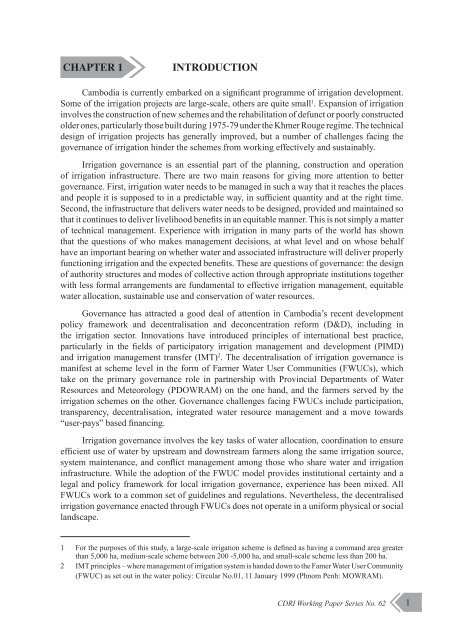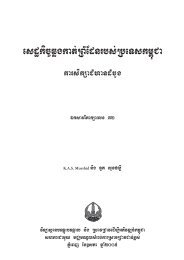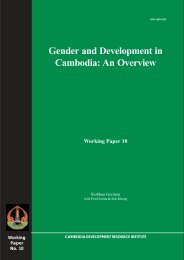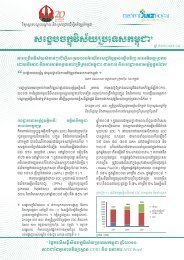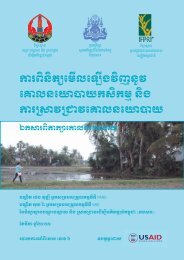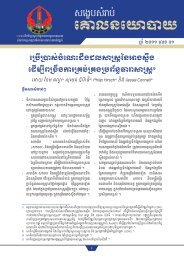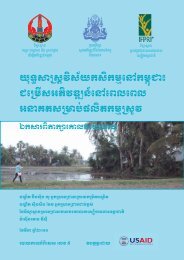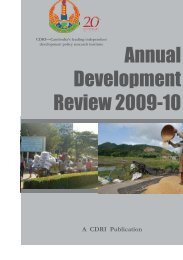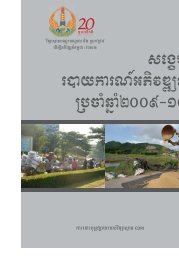62) decentralised governance of irrigation water in cambodia - CDRI
62) decentralised governance of irrigation water in cambodia - CDRI
62) decentralised governance of irrigation water in cambodia - CDRI
You also want an ePaper? Increase the reach of your titles
YUMPU automatically turns print PDFs into web optimized ePapers that Google loves.
CHAPTER 1 INTRODUCTION<br />
Cambodia is currently embarked on a significant programme <strong>of</strong> <strong>irrigation</strong> development.<br />
Some <strong>of</strong> the <strong>irrigation</strong> projects are large-scale, others are quite small 1 . Expansion <strong>of</strong> <strong>irrigation</strong><br />
<strong>in</strong>volves the construction <strong>of</strong> new schemes and the rehabilitation <strong>of</strong> defunct or poorly constructed<br />
older ones, particularly those built dur<strong>in</strong>g 1975-79 under the Khmer Rouge regime. The technical<br />
design <strong>of</strong> <strong>irrigation</strong> projects has generally improved, but a number <strong>of</strong> challenges fac<strong>in</strong>g the<br />
<strong>governance</strong> <strong>of</strong> <strong>irrigation</strong> h<strong>in</strong>der the schemes from work<strong>in</strong>g effectively and susta<strong>in</strong>ably.<br />
Irrigation <strong>governance</strong> is an essential part <strong>of</strong> the plann<strong>in</strong>g, construction and operation<br />
<strong>of</strong> <strong>irrigation</strong> <strong>in</strong>frastructure. There are two ma<strong>in</strong> reasons for giv<strong>in</strong>g more attention to better<br />
<strong>governance</strong>. First, <strong>irrigation</strong> <strong>water</strong> needs to be managed <strong>in</strong> such a way that it reaches the places<br />
and people it is supposed to <strong>in</strong> a predictable way, <strong>in</strong> sufficient quantity and at the right time.<br />
Second, the <strong>in</strong>frastructure that delivers <strong>water</strong> needs to be designed, provided and ma<strong>in</strong>ta<strong>in</strong>ed so<br />
that it cont<strong>in</strong>ues to deliver livelihood benefits <strong>in</strong> an equitable manner. This is not simply a matter<br />
<strong>of</strong> technical management. Experience with <strong>irrigation</strong> <strong>in</strong> many parts <strong>of</strong> the world has shown<br />
that the questions <strong>of</strong> who makes management decisions, at what level and on whose behalf<br />
have an important bear<strong>in</strong>g on whether <strong>water</strong> and associated <strong>in</strong>frastructure will deliver properly<br />
function<strong>in</strong>g <strong>irrigation</strong> and the expected benefits. These are questions <strong>of</strong> <strong>governance</strong>: the design<br />
<strong>of</strong> authority structures and modes <strong>of</strong> collective action through appropriate <strong>in</strong>stitutions together<br />
with less formal arrangements are fundamental to effective <strong>irrigation</strong> management, equitable<br />
<strong>water</strong> allocation, susta<strong>in</strong>able use and conservation <strong>of</strong> <strong>water</strong> resources.<br />
Governance has attracted a good deal <strong>of</strong> attention <strong>in</strong> Cambodia’s recent development<br />
policy framework and decentralisation and deconcentration reform (D&D), <strong>in</strong>clud<strong>in</strong>g <strong>in</strong><br />
the <strong>irrigation</strong> sector. Innovations have <strong>in</strong>troduced pr<strong>in</strong>ciples <strong>of</strong> <strong>in</strong>ternational best practice,<br />
particularly <strong>in</strong> the fields <strong>of</strong> participatory <strong>irrigation</strong> management and development (PIMD)<br />
and <strong>irrigation</strong> management transfer (IMT) 2 . The decentralisation <strong>of</strong> <strong>irrigation</strong> <strong>governance</strong> is<br />
manifest at scheme level <strong>in</strong> the form <strong>of</strong> Farmer Water User Communities (FWUCs), which<br />
take on the primary <strong>governance</strong> role <strong>in</strong> partnership with Prov<strong>in</strong>cial Departments <strong>of</strong> Water<br />
Resources and Meteorology (PDOWRAM) on the one hand, and the farmers served by the<br />
<strong>irrigation</strong> schemes on the other. Governance challenges fac<strong>in</strong>g FWUCs <strong>in</strong>clude participation,<br />
transparency, decentralisation, <strong>in</strong>tegrated <strong>water</strong> resource management and a move towards<br />
“user-pays” based f<strong>in</strong>anc<strong>in</strong>g.<br />
Irrigation <strong>governance</strong> <strong>in</strong>volves the key tasks <strong>of</strong> <strong>water</strong> allocation, coord<strong>in</strong>ation to ensure<br />
efficient use <strong>of</strong> <strong>water</strong> by upstream and downstream farmers along the same <strong>irrigation</strong> source,<br />
system ma<strong>in</strong>tenance, and conflict management among those who share <strong>water</strong> and <strong>irrigation</strong><br />
<strong>in</strong>frastructure. While the adoption <strong>of</strong> the FWUC model provides <strong>in</strong>stitutional certa<strong>in</strong>ty and a<br />
legal and policy framework for local <strong>irrigation</strong> <strong>governance</strong>, experience has been mixed. All<br />
FWUCs work to a common set <strong>of</strong> guidel<strong>in</strong>es and regulations. Nevertheless, the <strong>decentralised</strong><br />
<strong>irrigation</strong> <strong>governance</strong> enacted through FWUCs does not operate <strong>in</strong> a uniform physical or social<br />
landscape.<br />
1 For the purposes <strong>of</strong> this study, a large-scale <strong>irrigation</strong> scheme is def<strong>in</strong>ed as hav<strong>in</strong>g a command area greater<br />
than 5,000 ha, medium-scale scheme between 200 -5,000 ha, and small-scale scheme less than 200 ha.<br />
2 IMT pr<strong>in</strong>ciples – where management <strong>of</strong> <strong>irrigation</strong> system is handed down to the Famer Water User Community<br />
(FWUC) as set out <strong>in</strong> the <strong>water</strong> policy: Circular No.01, 11 January 1999 (Phnom Penh: MOWRAM).<br />
<strong>CDRI</strong> Work<strong>in</strong>g Paper Series No. <strong>62</strong><br />
1


